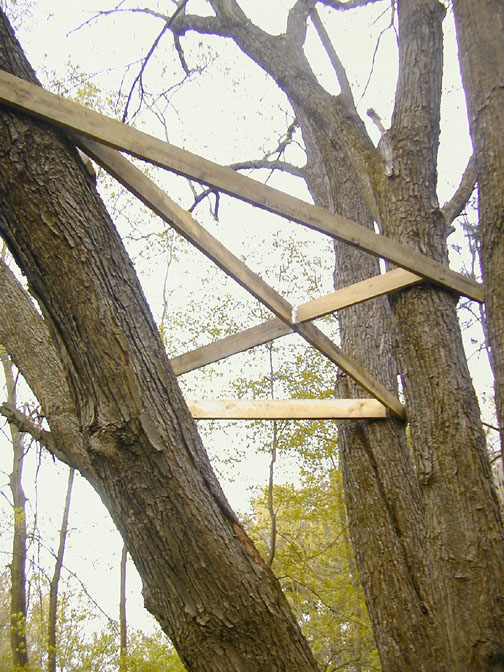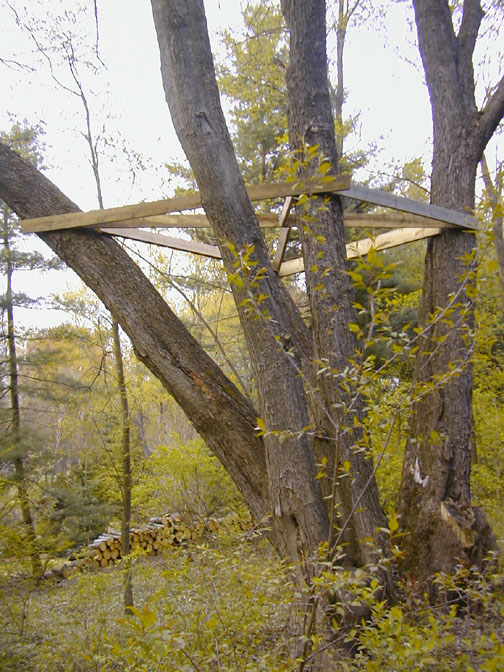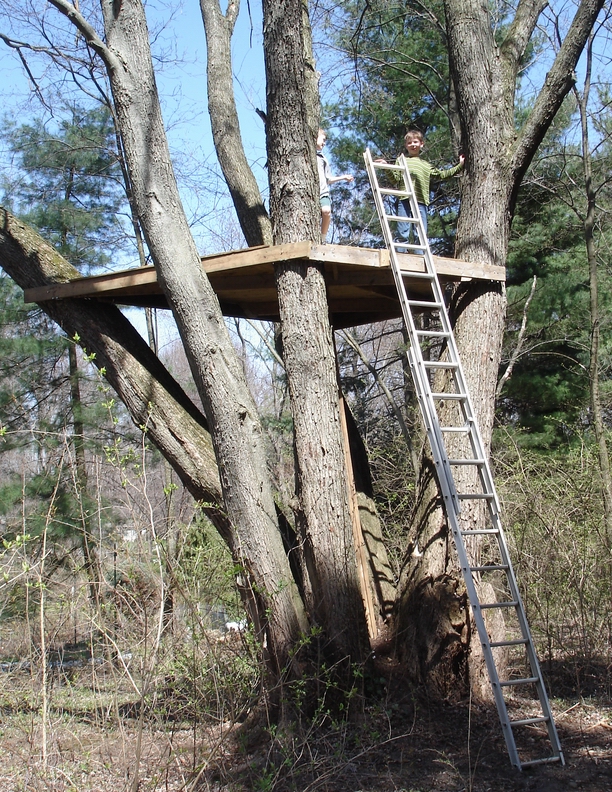UPDATE!
I finally finished the fort! It’s tall and strong. And dangerous to make sure it’s safe. Nothing makes kids more cautious than no railings. They go up and get real quiet and sit right down. It’s strong enough for a few adults to have a picnic up there, too.
(3/4″ wolmo-ply on lots of 2×6 joists with a center post. Attached to trunks with heavy bolts thru slots in the wood so trees can sway without stressing the fort. Frames are also resting on bolts.)
I also put up the Really High Fort in a local 50-foot tall tree, up where it sways. It’s just a 4-foot wedge platform with a couple armrests. A little hangout.
Update 3/16/06
Our treefort still looks like the framework photo below (actually worse). So this spring it’s definitely time to finish it. (Time, time, time!)
I just read the latest issue of Backwoodsman (great mag). The editor has put a call out for treehouse info. (Smart guy.) This new issue includes an article by an official and experienced treehouse builder. His summary: to build permanently and to code the obvious fact is that you can’t build in a tree. So he shows a basic way to build a cabin on stilts up in the trees—but not connected to them. His 3 obvious reasons are: safety due to heavy loads and lightning; fragility due to tree-death; code violations. I would also add: expense. (His simple cabin would be $35K to have built, $15K DIY, but much less if you salvaged materials.)
My answer to his situation is not to question his obvious skill at building good structures but to add another category that corrects the flaws he mentions. Let’s consider a temporary, lightweight shelter that doesn’t (greatly) injure the tree! (The lightning issue would seem easily solved via a lightning rod strapped to top of tree and wired to the earth. Would that do it?)
The pages of Backwoodsman are full of nifty jiffy shelters. Let’s just put one in a tree. In fact, that elevated house was the fanciest building I’ve seen in that mag. (No complaint—let’s just call it the far-end of the spectrum.)
First, let’s not design it to support very many people. And let’s make all its amenities tiny. Well, let’s just see how my take on the project works out. My treehouse will be simple indeed! Probably just a platform. I suspect that one stout bolt per each of 4 big trunk-limbs won’t hurt the tree too bad. They’ll ride in slots in my joists to give in the wind. Maybe someday I’ll put a light roof on it. Maybe some bug-screen around it. One step at a time!
***
FIRST REPORT, 5/22/05
Our kids are just getting big enough to climb trees. I couldn’t take it any longer and am starting to build treeforts. I’ll make one for them, then one for me. Theirs will be just high enough to be scary and dangerous—and make a lovely lunch spot (with pulley to haul up goodies). I’m guessing it’s about 13′ high.
I’m thinking of using a rope ladder—if a kid is fit/nimble enough to climb it, they’ll probably be safe enough on the platform. OK, I’ll probably put a rail around it, too.
This is a photo of the first stage of action. I’ll add a couple more joists to support the edges of a couple sheets of wolmanized plywood and we’ll be on our way. (I’ll add more pics as we build along.)
This is a Populist treefort. But one can get fancier without much more effort. There are lots of helpful books and websites out there, showing forts from primitive to high-end. Peter Nelson is the tree house guru, but I’m more inspired by the DIY-dads out there. No…I’m MOST inspired by the KIDS who sneak tools and supplies into woods and vacant lots and build their own!
My next fort will be a tiny one, WAY high up, a real hidey place, just for one person to hang out on. (I’ve already scoped it out and measured the board and brace I’ll need.) It’s 50 feet up in a spruce, on a hill, near our yard, where the trunk is only 12″ thick and sways a LOT. Oh yeah! I’ll be riding the storm out, just like ol’ John Muir! (Anyone read his story about riding the storm out in a sequoia?)
I’ll paint both of my forts camo—casual structures don’t need attention.
Now, everyone knows that a multi-trunk fort has to have sway-flex built in, to tolerate motion without damaging the fort (or tree). My method is to drill several holes in my supports, to make a 2″ horizontal slot, then I lag-bolt thru the slots. This allows for the big trunks to move a bit. (The smaller the trunk, the higher the fort, the more the sway, the longer the slots.)
Finished fort!

Nice view of early framing.



